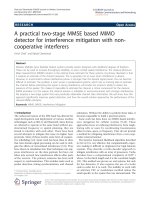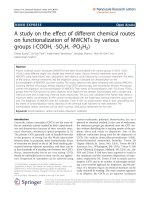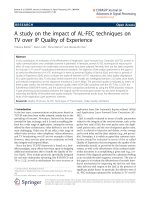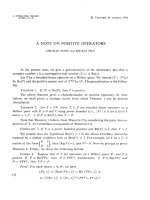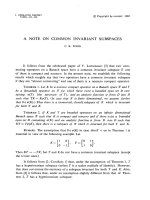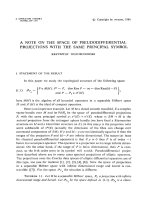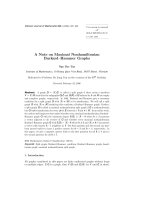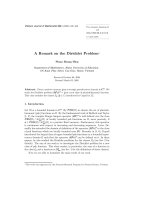Báo cáo toán học: " A note on the almost sure limit theorem for self-normalized partial sums of random variables in the domain of attraction of the normal law" pptx
Bạn đang xem bản rút gọn của tài liệu. Xem và tải ngay bản đầy đủ của tài liệu tại đây (182.41 KB, 13 trang )
This Provisional PDF corresponds to the article as it appeared upon acceptance. Fully formatted
PDF and full text (HTML) versions will be made available soon.
A note on the almost sure limit theorem for self-normalized partial sums of
random variables in the domain of attraction of the normal law
Journal of Inequalities and Applications 2012, 2012:17 doi:10.1186/1029-242X-2012-17
Qunying Wu ()
ISSN 1029-242X
Article type Research
Submission date 4 August 2011
Acceptance date 20 January 2012
Publication date 20 January 2012
Article URL />This peer-reviewed article was published immediately upon acceptance. It can be downloaded,
printed and distributed freely for any purposes (see copyright notice below).
For information about publishing your research in Journal of Inequalities and Applications go to
/>For information about other SpringerOpen publications go to
Journal of Inequalities and
Applications
© 2012 Wu ; licensee Springer.
This is an open access article distributed under the terms of the Creative Commons Attribution License ( />which permits unrestricted use, distribution, and reproduction in any medium, provided the original work is properly cited.
A note on the almost sure limit theorem for self-normalized
partial sums of random variables in the domain of attraction of
the normal law
Qunying Wu
1,2
1
College of Science, Guilin University of Technology,
Guilin 541004, P. R. China
2
Guangxi Key Laboratory of Spatial Information and Geomatics,
Guilin 541004, P.R. China
Email address:
Abstract
Let X, X
1
, X
2
, . . . be a sequence of independent and identically distributed random variables in the domain of attraction
of a normal distribution. A universal result in almost sure limit theorem for the self-normalized partial sums S
n
/V
n
is
established, where S
n
=
n
i=1
X
i
, V
2
n
=
n
i=1
X
2
i
.
Mathematical Scientific Classification: 60F15.
Keywords: domain of attraction of the normal law; self-normalized partial sums; almost sure central limit theorem.
1. Introduction
Throughout this article, we assume {X, X
n
}
n∈N
is a sequence of independent and identically distributed (i.i.d.)
random variables with a non-degenerate distribution function F. For each n ≥ 1, the symbol S
n
/V
n
denotes self-
normalized partial sums, where S
n
=
n
i=1
X
i
, V
2
n
=
n
i=1
X
2
i
. We say that the random variable X belongs to the domain
of attraction of the normal law, if there exist constants a
n
> 0, b
n
∈ R such that
S
n
− b
n
a
n
d
−→ N, (1)
where N is the standard normal random variable. We say that {X
n
}
n∈N
satisfies the central limit theorem (CLT).
It is known that (1) holds if and only if
lim
x→∞
x
2
P(|X| > x)
EX
2
I(|X| ≤ x)
= 0. (2)
In contrast to the well-known classical central limit theorem, Gine et al. [1] obtained the following self-normalized
version of the central limit theorem: (S
n
− ES
n
)/V
n
d
−→ N as n → ∞ if and only if (2) holds.
Brosamler [2] and Schatte [3] obtained the following almost sure central limit theorem (ASCLT): Let {X
n
}
n∈N
be
i.i.d. random variables with mean 0, variance σ
2
> 0 and partial sums S
n
. Then
lim
n→∞
1
D
n
n
k=1
d
k
I
S
k
σ
√
k
< x
= Φ(x) a.s. for all x ∈ R, (3)
with d
k
= 1/k and D
n
=
n
k=1
d
k
, where I denotes an indicator function, and Φ(x) is the standard normal distribution
function. Some ASCLT results for partial sums were obtained by Lacey and Philipp [4], Ibragimov and Lifshits [5],
Miao [6], Berkes and Cs
´
aki [7], H
¨
ormann [8], Wu [9, 10], and Ye and Wu [11]. Huang and Zhang [12] and Zhang
and Yang [13] obtained ASCLT results for self-normalized version.
Under mild moment conditions ASCLT follows from the ordinary CLT, but in general the validity of ASCLT is a
delicate question of a totally different character as CLT. The difference between CLT and ASCLT lies in the weight in
ASCLT.
The terminology of summation procedures (see, e.g., Chandrasekharan and Minakshisundaram [14, p. 35]) shows
that the large the weight sequence {d
k
; k ≥ 1} in (3) is, the stronger the relation becomes. By this argument, one should
also expect to get stronger results if we use larger weights. And it would be of considerable interest to determine the
optimal weights.
On the other hand, by the Theorem 1 of Schatte [3], Equation (3) fails for weight d
k
= 1. The optimal weight
sequence remains unknown.
The purpose of this article is to study and establish the ASCLT for self-normalized partial sums of random variables
in the domain of attraction of the normal law, we will show that the ASCLT holds under a fairly general growth
condition on d
k
= k
−1
exp(ln k)
α
), 0 ≤ α < 1/2.
Our theorem is formulated in a more general setting.
2
Theorem 1.1. Let {X, X
n
}
n∈N
be a sequence of i.i.d. random variables in the domain of attraction of the normal law
with mean zero. Suppose 0 ≤ α < 1/2 and set
d
k
=
exp(ln
α
k)
k
, D
n
=
n
k=1
d
k
. (4)
Then
lim
n→∞
1
D
n
n
k=1
d
k
I
S
k
V
k
≤ x
= Φ(x) a.s. for any x ∈ R. (5)
By the terminology of summation procedures, we have the following corollary.
Corollary 1.2. Theorem 1.1 remains valid if we replace the weight sequence {d
k
}
k∈N
by any {d
∗
k
}
k∈N
such that 0 ≤
d
∗
k
≤ d
k
,
∞
k=1
d
∗
k
= ∞.
Remark 1.3. Our results not only give substantial improvements for weight sequence in theorem 1.1 obtained by
Huang [12] but also removed the condition nP(|X
1
| > η
n
) ≤ c(log n)
ε
0
, 0 < ε
0
< 1 in theorem 1.1 of [12].
Remark 1.4. If EX
2
< ∞, then X is in the domain of attraction of the normal law. Therefore, the class of random
variables in Theorems 1.1 is of very broad range.
Remark 1.5. Essentially, the open problem should be whether Theorem 1.1 holds for 1/2 ≤ α < 1 remains open.
2. Proofs
In the following, a
n
∼ b
n
denotes lim
n→∞
a
n
/b
n
= 1. The symbol c stands for a generic positive constant which
may differ from one place to another.
Furthermore, the following three lemmas will be useful in the proof, and the first is due to [15].
Lemma 2.1. Let X be a random variable with EX = 0, and denote l(x) = EX
2
I{|X| ≤ x}. The following statements
are equivalent:
(i) X is in the domain of attraction of the normal law.
(ii) x
2
P(|X| > x) = o(l(x)).
(iii) xE(|X|I(|X| > x)) = o(l(x)).
(iv) E(|X|
α
I(|X| ≤ x)) = o(x
α−2
l(x)) for α > 2.
Lemma 2.2. Let {ξ, ξ
n
}
n∈N
be a sequence of uniformly bounded random variables. If exist constants c > 0 and δ > 0
such that
|Eξ
k
ξ
j
| ≤ c
k
j
δ
, for 1 ≤ k < j, (6)
then
lim
n→∞
1
D
n
n
k=1
d
k
ξ
k
= 0 a.s., (7)
where d
k
and D
n
are defined by (4).
3
Proof. Since
E
n
k=1
d
k
ξ
k
2
≤
n
k=1
d
2
k
Eξ
2
k
+ 2
1≤k< j≤n
d
k
d
j
|Eξ
k
ξ
j
|
=
n
k=1
d
2
k
Eξ
2
k
+ 2
1≤k< j≤n; j/k≥ln
2/δ
D
n
d
k
d
j
|Eξ
k
ξ
l
| + 2
1≤k< j≤n; j/k<ln
2/δ
D
n
d
k
d
j
|Eξ
k
ξ
l
|
:= T
n1
+ 2(T
n2
+ T
n3
). (8)
By the assumption of Lemma 2.2, there exists a constant c > 0 such that |ξ
k
| ≤ c for any k. Noting that exp(ln
α
x) =
exp(
x
1
α(ln u)
α−1
u
du), we have exp(ln
α
x), α < 1 is a slowly varying function at infinity. Hence,
T
n1
≤ c
n
k=1
exp(2 ln
α
k)
k
2
≤ c
∞
k=1
exp(2 ln
α
k)
k
2
< ∞.
By (6),
T
n2
≤ c
1≤k< j≤n; j/k≥ln
2/δ
D
n
d
k
d
j
k
j
δ
≤ c
1≤k< j≤n; j/k≥ln
2/δ
D
n
d
k
d
j
ln
2
D
n
≤
cD
2
n
ln
2
D
n
. (9)
On the other hand, if α = 0, we have d
k
= e/k, D
n
∼ e ln n, hence, for sufficiently large n,
T
n3
≤ c
n
k=1
1
k
k ln
2/δ
D
n
j=k
1
j
≤ cD
n
ln ln D
n
≤
D
2
n
ln
2
D
n
. (10)
If α > 0, note that
D
n
∼
n
1
exp(ln
α
x)
x
dx =
ln n
0
exp(y
α
)dy
∼
ln n
0
exp(y
α
) +
1 − α
α
y
−α
exp(y
α
)
dy
=
ln n
0
1
α
y
1−α
exp(y
α
)
dy
=
1
α
ln
1−α
n exp(ln
α
n), n → ∞. (11)
This implies
ln D
n
∼ ln
α
n, exp(ln
α
n) ∼
αD
n
(ln D
n
)
1−α
α
, ln ln D
n
∼ α ln ln n.
4
Thus combining |ξ
k
| ≤ c for any k,
T
n3
≤ c
n
k=1
d
k
1≤k< j≤n; j/k<(ln D
n
)
2/δ
d
j
≤ c
n
k=1
d
k
k< j≤k(ln D
n
)
2/δ
exp(ln
α
n)
1
j
≤ c exp(ln
α
n) ln ln D
n
n
k=1
d
k
≤ c
D
2
n
ln ln D
n
(ln D
n
)
(1−α)/α
.
Since α < 1/2 implies (1 − 2α)/(2α) > 0 and ε
1
:= 1/(2α) − 1 > 0. Thus, for sufficiently large n, we get
T
n3
≤ c
D
2
n
(ln D
n
)
1/(2α)
ln ln D
n
(ln D
n
)
(1−2α)/(2α)
≤
D
2
n
(ln D
n
)
1/(2α)
=
D
2
n
(ln D
n
)
1+ε
1
. (12)
Let T
n
:=
1
D
n
n
k=1
d
k
ξ
k
, ε
2
:= min(1, ε
1
). Combining (8)-(12), for sufficiently large n, we get
ET
2
n
≤
c
(ln D
n
)
1+ε
2
.
By (11), we have D
n+1
∼ D
n
. Let 0 < η < ε
2
/(1 + ε
2
), n
k
= inf{n; D
n
≥ exp(k
1−η
)}, then D
n
k
≥ exp(k
1−η
), D
n
k
−1
<
exp(k
1−η
). Therefore
1 ≤
D
n
k
exp(k
1−η
)
∼
D
n
k
−1
exp(k
1−η
)
< 1 → 1,
that is,
D
n
k
∼ exp(k
1−η
).
Since (1 − η)(1 + ε
2
) > 1 from the definition of η, thus for any ε > 0, we have
∞
k=1
P(|T
n
k
| > ε) ≤ c
∞
k=1
ET
2
n
k
≤ c
∞
k=1
1
k
(1−η)(1+ε
2
)
< ∞.
By the Borel-Cantelli lemma,
T
n
k
→ 0 a.s.
Now for n
k
< n ≤ n
k+1
, by |ξ
k
| ≤ c for any k,
|T
n
| ≤ |T
n
k
| +
c
D
n
k
n
k+1
i=n
k
+1
d
i
≤ |T
n
k
| + c
D
n
k+1
D
n
k
− 1
→ 0 a.s.
5
from
D
n
k+1
D
n
k
∼
exp((k+1)
1−η
)
exp(k
1−η
)
= exp(k
1−η
((1 + 1/k)
1−η
−1)) ∼ exp((1 −η)k
−η
) → 1. I.e., (7) holds. This completes the proof
of Lemma 2.2.
Let l(x) = EX
2
I{|X| ≤ x}, b = inf{x ≥ 1; l(x) > 0} and
η
j
= inf
s; s ≥ b + 1,
l(s)
s
2
≤
1
j
for j ≥ 1.
By the definition of η
j
, we have jl(η
j
) ≤ η
2
j
and jl(η
j
− ε) > (η
j
− ε)
2
for any ε > 0. It implies that
nl(η
n
) ∼ η
2
n
, as n → ∞. (13)
For every 1 ≤ i ≤ n, let
¯
X
ni
= X
i
I(|X
i
| ≤ η
n
),
¯
S
n
=
n
i=1
¯
X
ni
,
¯
V
2
n
=
n
i=1
¯
X
2
ni
.
Lemma 2.3. Suppose that the assumptions of Theorem 1.1 hold. Then
lim
n→∞
1
D
n
n
k=1
d
k
I
¯
S
k
− E
¯
S
k
kl(η
k
)
≤ x
= Φ(x) a.s. for any x ∈ R, (14)
lim
n→∞
1
D
n
n
k=1
d
k
I
k
i=1
(|X
i
| > η
k
)
− EI
k
i=1
(|X
i
| > η
k
)
= 0 a.s., (15)
lim
n→∞
1
D
n
n
k=1
d
k
f
¯
V
2
k
kl(η
k
)
− E f
¯
V
2
k
kl(η
k
)
= 0 a.s., (16)
where d
k
and D
n
are defined by (4) and f is a non-negative, bounded Lipschitz function.
Proof. By the cental limit theorem for i.i.d. random variables and Var
¯
S
n
∼ nl(η
n
) as n → ∞ from EX = 0,
Lemma 2.1 (iii), and (13), it follows that
¯
S
n
− E
¯
S
n
nl(η
n
)
d
−→ N, as n → ∞,
where N denotes the standard normal random variable. This implies that for any g(x) which is a non-negative,
bounded Lipschitz function
6
Eg
¯
S
n
− E
¯
S
n
nl(η
n
)
−→ Eg(N), as n → ∞,
Hence, we obtain
lim
n→∞
1
D
n
n
k=1
d
k
Eg
¯
S
k
− E
¯
S
k
kl(η
k
)
= Eg(N)
from the Toeplitz lemma.
On the other hand, note that (14) is equivalent to
lim
n→∞
1
D
n
n
k=1
d
k
g
¯
S
k
− E
¯
S
k
kl(η
k
)
= Eg(N) a.s.
from Theorem 7.1 of [16] and Section 2 of [17]. Hence, to prove (14), it suffices to prove
lim
n→∞
1
D
n
n
k=1
d
k
g
¯
S
k
− E
¯
S
k
kl(η
k
)
− Eg
¯
S
k
− E
¯
S
k
kl(η
k
)
= 0 a.s., (17)
for any g(x) which is a non-negative, bounded Lipschitz function.
For any k ≥ 1, let
ξ
k
= g
¯
S
k
− E
¯
S
k
kl(η
k
)
− Eg
¯
S
k
− E
¯
S
k
kl(η
k
)
.
For any 1 ≤ k < j, note that g
¯
S
k
−E
¯
S
k
√
kl(η
k
)
and g
¯
S
j
−E
¯
S
j
−
k
i=1
(X
i
−EX
i
)I(|X
i
|≤η
j
)
√
jl(η
j
)
are independent and g(x) is a non-negative,
bounded Lipschitz function. By the definition of η
j
, we get,
|Eξ
k
ξ
j
| =
Cov
g
¯
S
k
− E
¯
S
k
kl(η
k
)
, g
¯
S
j
− E
¯
S
j
jl(η
j
)
=
Cov
g
¯
S
k
− E
¯
S
k
kl(η
k
)
, g
¯
S
j
− E
¯
S
j
jl(η
j
)
− g
¯
S
j
− E
¯
S
j
−
k
i=1
(X
i
− EX
i
)I(|X
i
| ≤ η
j
)
jl(η
j
)
≤ c
E
k
i=1
(X
i
− EX
i
)I(|X
i
| ≤ η
j
)
jl(η
j
)
≤ c
kEX
2
I(|X| ≤ η
j
)
jl(η
j
)
= c
k
j
1/2
.
7
By Lemma 2.2, (17) holds.
Now we prove (15). Let
Z
k
= I
k
i=1
(|X
i
| > η
k
)
− EI
k
i=1
(|X
i
| > η
k
)
for any k ≥ 1.
It is known that I(A ∪ B) − I(B) ≤ I(A) for any sets A and B, then for 1 ≤ k < j, by Lemma 2.1 (ii) and (13), we
get
P(|X| > η
j
) = o(1)
l(η
j
)
η
2
j
=
o(1)
j
. (18)
Hence
|EZ
k
Z
j
| =
Cov
I
k
i=1
(|X
i
| > η
k
)
, I
j
i=1
(|X
i
| > η
j
)
=
Cov
I
k
i=1
(|X
i
| > η
k
)
, I
j
i=1
(|X
i
| > η
j
)
− I
j
i=k+1
(|X
i
| > η
j
)
≤ E
I
j
i=1
(|X
i
| > η
j
)
− I
j
i=k+1
(|X
i
| > η
j
)
≤ EI
k
i=1
(|X
i
| > η
j
)
≤ kP(|X| > η
j
)
≤
k
j
.
By Lemma 2.2, (15) holds.
Finally, we prove (16). Let
ζ
k
= f
¯
V
2
k
kl(η
k
)
− E f
¯
V
2
k
kl(η
k
)
for any k ≥ 1.
For 1 ≤ k < j,
|Eζ
k
ζ
j
| =
Cov
f
¯
V
2
k
kl(η
k
)
, f
¯
V
2
j
jl(η
j
)
8
=
Cov
f
¯
V
2
k
kl(η
k
)
, f
¯
V
2
j
jl(η
j
)
− f
¯
V
2
j
−
k
i=1
X
2
i
I(|X
i
| ≤ η
j
)
jl(η
j
)
≤ c
E
k
i=1
X
2
i
I(|X
i
| ≤ η
j
)
jl(η
j
)
= c
kEX
2
I(|X| ≤ η
j
)
jl(η
j
)
= c
kl(η
j
)
jl(η
j
)
= c
k
j
.
By Lemma 2.2, (16) holds. This completes the proof of Lemma 2.3.
Proof of Theorem 1.1. For any given 0 < ε < 1, note that
I
S
k
V
k
≤ x
≤ I
¯
S
k
(1 + ε)kl(η
k
)
≤ x
+ I
¯
V
2
k
> (1 + ε)kl(η
k
)
+ I
k
i=1
|X
i
| > η
k
)
, for x ≥ 0,
I
S
k
V
k
≤ x
≤ I
¯
S
k
(1 − ε)kl(η
k
)
≤ x
+ I
¯
V
2
k
< (1 − ε)kl(η
k
)
+ I
k
i=1
|X
i
| > η
k
)
, for x < 0,
and
I
S
k
V
k
≤ x
≥ I
¯
S
k
(1 − ε)kl(η
k
)
≤ x
− I
¯
V
2
k
< (1 − ε)kl(η
k
)
− I
k
i=1
|X
i
| > η
k
)
, for x ≥ 0,
I
S
k
V
k
≤ x
≥ I
¯
S
k
(1 + ε)kl(η
k
)
≤ x
− I
¯
V
2
k
> (1 + ε)kl(η
k
)
− I
k
i=1
|X
i
| > η
k
)
, for x < 0.
Hence, to prove (5), it suffices to prove
lim
n→∞
1
D
n
n
k=1
d
k
I
¯
S
k
kl(η
k
)
≤
√
1 ± εx
= Φ(
√
1 ± εx) a.s., (19)
lim
n→∞
1
D
n
n
k=1
d
k
I
k
i=1
|X
i
| > η
k
)
= 0 a.s., (20)
lim
n→∞
1
D
n
n
k=1
d
k
I(
¯
V
2
k
> (1 + ε)kl(η
k
)) = 0 a.s., (21)
9
lim
n→∞
1
D
n
n
k=1
d
k
I(
¯
V
2
k
< (1 − ε)kl(η
k
)) = 0 a.s. (22)
by the arbitrariness of ε > 0.
Firstly, we prove (19). Let 0 < β < 1/2 and h(·) be a real function, such that for any given x ∈ R,
I(y ≤
√
1 ± εx − β) ≤ h(y) ≤ I(y ≤
√
1 ± εx + β). (23)
By EX = 0, Lemma 2.1 (iii) and (13), we have
|E
¯
S
k
| = |kEXI(|X| ≤ η
k
)| = |kEXI(|X| > η
k
)| ≤ kE|X|I(|X| > η
k
) = o(
kl(η
k
)).
This, combining with (14), (23) and the arbitrariness of β in (23), (19) holds.
By (15), (18) and the Toeplitz lemma,
0 ≤
1
D
n
n
k=1
d
k
I
k
i=1
|X
i
| > η
k
)
∼
1
D
n
n
k=1
d
k
EI
k
i=1
|X
i
| > η
k
)
≤
1
D
n
n
k=1
d
k
kP(|X| > η
k
) → 0 a.s.
That is (20) holds.
Now we prove (21). For any µ > 0, let f be a non-negative, bounded Lipschitz function such that
I(x > 1 + µ) ≤ f (x) ≤ I(x > 1 + µ/2).
Form E
¯
V
2
k
= kl(η
k
),
¯
X
ni
is i.i.d., Lemma 2.1 (iv), and (13),
P
¯
V
2
k
>
1 +
µ
2
kl(η
k
)
= P
¯
V
2
k
− E
¯
V
2
k
>
µ
2
kl(η
k
)
≤ c
E(
¯
V
2
k
− E
¯
V
2
k
)
2
k
2
l
2
(η
k
)
≤ c
EX
4
I(|X| ≤ η
k
)
kl
2
(η
k
)
=
o(1)η
2
k
kl(η
k
)
= o(1) → 0.
10
Therefore, from (16) and the Toeplitz lemma,
0 ≤
1
D
n
n
k=1
d
k
I
¯
V
2
k
> (1 + µ)kl(η
k
)
≤
1
D
n
n
k=1
d
k
f
¯
V
2
k
kl(η
k
)
∼
1
D
n
n
k=1
d
k
E f
¯
V
2
k
kl(η
k
)
≤
1
D
n
n
k=1
d
k
EI
¯
V
2
k
> (1 + µ/2)kl(η
k
)
=
1
D
n
n
k=1
d
k
P(
¯
V
2
k
> (1 + µ/2)kl(η
k
))
→ 0 a.s.
Hence, (21) holds. By similar methods used to prove (21), we can prove (22). This completes the proof of Theo-
rem 1.1.
Competing interests
The author declares that she has no competing interests.
Acknowledgments
The author was very grateful to the referees and the Editors for their valuable comments and some helpful sug-
gestions that improved the clarity and readability of the paper. This work was supported by the National Natural
Science Foundation of China (11061012), the project supported by program to Sponsor Teams for Innovation in the
Construction of Talent Highlands in Guangxi Institutions of Higher Learning ([2011]47), and the support program of
Key Laboratory of Spatial Information and Geomatics (1103108-08).
References
[1] Gine, E, G
¨
otze, F, Mason, DM: When is the Student t-statistic asymptotically standard normal? Ann. Probab. 25, 1514–531 (1997)
[2] Brosamler, GA: An almost everywhere central limit theorem. Math. Proc. Camb. Philos. Soc. 104, 561–574 (1988)
[3] Schatte, P: On strong versions of the central limit theorem. Mathematische Nachrichten. 137, 249–256 (1988)
[4] Lacey, MT, Philipp, W: A note on the almost sure central limit theorem. Statist. Probab. Lett. 9, 201–205 (1990)
[5] Ibragimov, IA, Lifshits, M: On the convergence of generalized moments in almost sure central limit theorem. Stat. Probab. Lett. 40, 343–351
(1998)
11
[6] Miao, Y: Central limit theorem and almost sure central limit theorem for the product of some partial sums. Proc. Indian Acad. Sci. C. Math.
Sci. 118(2), 289–294 (2008)
[7] Berkes, I, Cs
´
aki, E: A universal result in almost sure central limit theory. Stoch. Proc. Appl. 94, 105–134 (2001)
[8] H
¨
ormann, S: Critical behavior in almost sure central limit theory. J. Theoret. Probab. 20, 613–636 (2007)
[9] Wu, QY: Almost sure limit theorems for stable distribution. Stat. Probab. Lett. 281(6), 662–672 (2011)
[10] Wu, QY: An almost sure central limit theorem for the weight function sequences of NA random variables. Proc. Math. Sci. 121(3), 369–377
(2011)
[11] Ye, DX, Wu, QY: Almost sure central limit theorem of product of partial sums for strongly mixing. J. Inequal. Appl. vol. 2011, Article ID
576301, 9 (2011)
[12] Huang, SH, Pang, TX: An almost sure central limit theorem for self-normalized partial sums. Comput. Math. Appl. 60, 2639–2644 (2010)
[13] Zhang, Y, Yang, XY: An almost sure central limit theorem for self-normalized products of sums of i.i.d. random variables. J. Math. Anal.
Appl. 376, 29–41 (2011)
[14] Chandrasekharan, K, Minakshisundaram, S: Typical Means. Oxford University Press, Oxford (1952)
[15] Cs
¨
orgo, M, Szyszkowicz, B, Wang, QY: Donsker’s theorem for self-normalized partial processes. Ann. Probab. 31(3), 1228–1240 (2003)
[16] Billingsley, P (ed.): Convergence of Probability Measures. Wiley, New York (1968)
[17] Peligrad, M, Shao, QM: A note on the almost sure central limit theorem for weakly dependent random variables. Stat. Probab. Lett. 22,
131–136 (1995)
12

